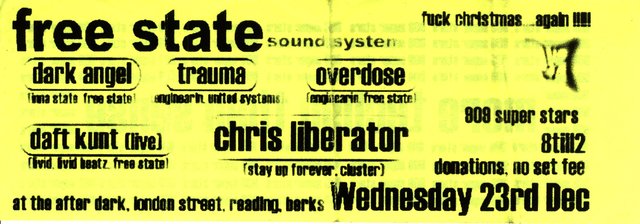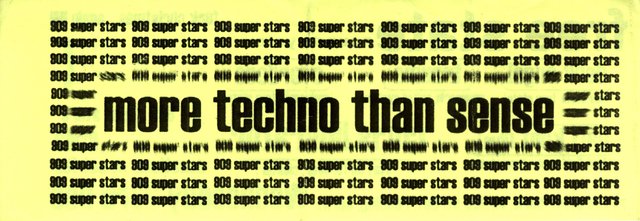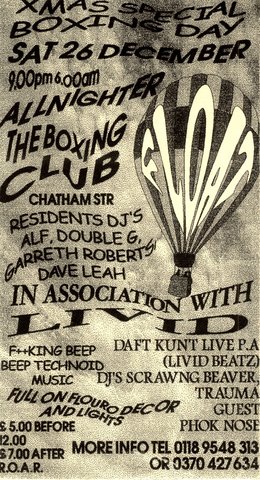
Serendipity
Nick Leverton
nick@leverton.org
![]()
Live updates
RSSTopics
- Books - 1
- Cats - 17
- Junior - 4
- Kittens - 6
- Mitsi - 3
- Tinker - 2
- DIY - 3
- International - 3
- South Africa - 2
- Zimbabwe - 1
- Internet - 1
- Music - 24
- Downloads - 8
- Parties - 14
- People+Places - 4
- Blogosphere - 1
- Colourscape - 1
- Linlithgow - 1
- Stonehenge - 1
- Photogallery - 22
- Bridges & Tunnels - 6
- Buses - 2
- Rail - 7
- Slate Rails of Wales - 6
- Walks - 1
- Politics - 3
- Internet - 2
- Rail - 6
- South Africa - 1
- UK - 4
- Science - 1
- Security - 3
- Software - 13
- Linux - 1
- MSDOS - 1
- Neat Ideas - 1
- Projects - 9
- Windows - 1
- Usenet - 7
- Umra - 5
Blog Flavours
There's more than one way to view this weblog; try one of these flavours.
Links
This site: Other sites:BOFH excuse of the day
Serendipity
Mon, 06 Jul 2020Lost The Plot - RSU Reading - 1999-03-05
Gosh. It's a long time since I've typed a 1990s date in the blog heading.
This Party - Plots Lost - Lost The Plot
Music: Audio Pancake - Live@LTP - 1999 uploaded by magic_teacup
Blosxom moreentries plugin bug fixes
Blosxom Plug-in: moreentries
The moreentries plugin for Blosxom, which gives "prev" and "next" links when an index exceeds a certain number of stories, did not work if the directory pathname contained special characters for regular expressions, such as '+' or '*' or '?'.
Steve Schwarz, steve at agilitynerd.com, did some good work on moreentries to add multiple prev/next pages, and brought the plugin up to version 0.3.
Version 0.4 (0+4i) solved the special characters bug for moreentries by quoting the regular expression it uses to select postings. It is also safe for Perl's "use warnings" and "use strict".
Version 0.4.1 (0+4.1i) correctly quoted a naked ampersand.
Version 0.4.2 (0+4.2i) added a fix where some installations of CGI.pm didn't give us the expected value of self_url, meaning that prev and next links in categories instead went to the blog top level.
moreentries plugin v0.4.2 (0+4.2i), with documentation.
Photogallery: Rail: D4 and other Peaks
Broadcom 43xx 802.11 wireless channels
Eldest Daughter wanted Vista on her emachines E520 laptop, so we shelled out the extortionate sum of 90-odd quid for a CD, a small brochure and a torn paper sticker with five groups of five letters on. Made sure I bought Vista SP1 so as to get the latest fixes and driver updates (this was before SP2 was released, of course). Oh how naïve I was imaging that to be the case ...
You might have thought that Micro$oft would ensure their flagship operating system comes with support for the most common hardware one is likely to want to install it on. Especially by the time it's had a service pack release. But no.
Have you got an Intel Mobile 4 chipset PCI, IDE or video ? Intel ? minor company, not worth Microsoft's while working with them for hardware support. Little yellow triangle with an exclamation mark, all over the hardware properties for all of them.
This is a bit of a problem if you also find that Vista doesn't support Broadcom 802.11 wireless - far too left-field mate, Vista doesn't support it out of the box. Little yellow triangles for wireless network drivers.
And Vista doesn't support the Realtek 8168 ethernet chip. Realtek, focussing on the cheap personal computer end of the market - not at all the business segment Vista Home is addressing, so little yellow triangles on the ethernet too.
So you install Vista, you have no networking at all and a fuzzy low-quality display, and you have to get this hardware into a usable state. Naturally I used a Debian live CD to go online and research what a pile of kak I'd just been handed by Microsoft.
I managed to find drivers for everything on the laptop manufacturer's website - except that the most recent Vista Broadcom 43xx wireless driver, 4.170.25.19, doesn't support European wireless channel range. The XP one is more recent and has this fixed, but not for Vista mate. If you drill right down into the driver properties you find that it offers two country settings in the Location dropdown: "US" and "Default". "US" apparently supports the US 801.11b/g channel range of 1 to 11, whereas "Default" offers the full range of .. yes, channels 1 to 11. Which is a bit stupid when you remember that everywhere outside the US and Japan actually has 13 wireless channels, so there is a 15% chance that your expensive copy of Vista will be a paperweight as far as any given wireless access point is concerned.
Having spent two weekends fighting this, it eventually turns out that the driver is properly written. You can edit the registry with the correct country code and you will get all 13 channels. It's merely the crappy installer written by Acer/eMachines/Gateway (the only people to have packaged the latest Broadcom driver as far as I can find).
To find the key use "regedit -v" and search for a Value field of "Country". Make sure you're looking at the Broadcom drivers by looking at the keys above and below it. If you're sure you are in the right place, then edit the Data field to say "GB". Repeat for as many copies of the registry key as you can find - there seem to be 3 on this machine. Reboot (we all know Windows needs to reboot every time you breathe) and you should now be able to access all 13 wireless channels.
If you stuff this up bear in mind that I know almost nothing about Vista and won't be able to help you fix it. But I hope the information is useful to anyone facing the same lack of 802.11 channel 13 with the Broadcom 802.11 Vista driver.
Corris and Aberllefeni
Government Browser Standards consultation
10 September 2008
Dear Sirs
Re: Web site accessibility and “browser standards draft”
http://www.coi.gov.uk/documents/guidance/browser-standards-draft-v0-13.pdf
I fear there is a fundamentally incorrect assumption behind your consultation document on web site accessibility in the guise of “browser compatibility”.
I agree with the premise of your consultation, that Government and other web site owners should be assured that their sites will be accessible using all commonly used browsers, and on special browsers designed for the impaired.
However I believe this aim, of correct display on the most commonly used browsers, may be better achieved by ensuring adherence to the underlying standards which all conforming browsers – the majority – implement. This as distinct from creating something which “works” on particular browsers by quirk, rather than because it is correctly designed and programmed.
However this latter “design by quirk” is a major risk of recommending that web sites just developed by testing with the majority browsers, rather than requiring that the job be done to accepted and common interoperability standards – those for HTML, XML, and ECMAscript (Javascript). These standards are clear, public, and universally accepted as defining the means of correct interoperability, and they are backed up by freely available validation software.
As a result it is a simple matter to ensure that the web site output is correct and interoperable. This can be done as a routine part of development, even automatically, thus keeping costs down. Full browser compatibility checks can of course still be done but will be less necessary; for day to day use a check with one standards compliant browser will assure compliance with them all.
Your example in Appendix A supposes that every office of Government would have to review every function of every web site some six times, not a task likely to enthuse the tester and not one which is likely to be performed to consistent standards by the time the tester gets to the fifth or sixth browser. I would agree that reviewing your work on a browser is an essential part of the development cycle, but you will appreciate that reviewing every feature of a site by a human on each of four or five browsers, to ensure that it looks right and works right, is not a task that it is efficient to do very often.
By ensuring web site output that is compliant to standards, as a regular intermediate validation step in web site production, you can be assured that as browser standards also strive towards compliance, you and the browser developers are working towards common goals of interoperability.
Another risk of just “developing to browser standards” rather than “developing to interoperable standards” is that browsers come and go and so do their quirks.
It is likely that some Government web sites may be in service for several years without any functional change being needed. It is inefficient to rewrite every site just to produce new output should vendor A, for instance, release a new version of Outernet Exploder which rewrites the rules on the quirks for “most common browser”. However even Outernet Exploder is very likely to have a “standards” mode, which can be invoked just by making the correct declaration of standards compatibility in the web site output.
A third benefit of building web sites to standards is that most if not all browsers for the impaired actually use the interoperable web standards in order to function. These standards define ways to provide alternative renderings as needed, and if you work to the standards, you are automatically as functional as possible, whether it is for Lynx or a special browser for impaired needs.
This can be as simple as providing meaningful “alt” texts on images, and destination titles and descriptions on hyperlinks, or provision of audio alternatives via standard HTML tags, or can help full cross-device compatibility by ensuring that all active (Javascript or Java) content also has HTML form-based alternatives available for those browsing on restricted devices.
Again this can all be achieved and verified by the use of public validation tools as a regular and integrated part of web site development procedures.
Use of common standards also aids in reorganisations. By means of CSS, two quite dissimilar web sites can be made to resemble one another without loss of function. I have made such a merge in my own web site between two web site production software tools, and because they both produce compliant HTML, it is simple to split the functions of my web site between them and still achieve a common look and user interface. I can also easily choose to keep formerly functional URLs in use as aliases, even when I reorganise the outer pages of my site to reflect the owner's changing priorities, as Government web sites will assuredly also have to do.
I believe this would be a major advantage in combatting “link rot” in Government web sites – something which has recently plagued my own use of the reorganised Disability Discrimination web sites, having invalidated all references from outside web sites as well as my extensive collection of Disability Discrimination bookmarks from prior to the reorganisation.
Finally, by mandating conformance to testable standards, work can safely be tendered out if desired, to strictly comparable cost bases, and still easily verified as meeting acceptance criteria.
In this way all users can be quite sure that your site will work correctly in any browser they choose, leading to user choice and empowerment, and your commitment to widest user availability is demonstrated to the widest possible audience.
In its present form I cannot agree at all with the Browser Standards Draft, and I hope you will give serious consideration to the points stated above.
Yours faithfully
Killamarsh MS&LR
Howard Sprenger reported in September 2008 on derbyshirerailways, "Killamarsh station (latterly the premises of an architectural reclaiming company) is now due for demolition and has been offered for sale for £1. This is the last intact MSLR wooden Derbyshire Lines station"
Spurred by the ensuing thread I visited  Killamarsh. Pictures of the attractive station are attached. The canopy has been clad in corrugated PVC and can't be seen from the trackbed, though a few small holes high up give a tantalising glimpse inside - although not large enough to identify any features.
Killamarsh. Pictures of the attractive station are attached. The canopy has been clad in corrugated PVC and can't be seen from the trackbed, though a few small holes high up give a tantalising glimpse inside - although not large enough to identify any features.
Killamarsh MS&LR gallery
Upperthorpe & Killamarsh GCR
Ralph Rawlinson also asked,
>Incidentally am I correct in thinking that there is no trace trace of Upperthorpe & Killamarsh
>station (closed 1930) located where Field Lane bridges a cutting on the nearby Shirebrook line?
I spent a little while poking around the cutting at  Upperthorpe & Killamarsh too and couldn't find anything identifiable. The single track platform must have been demolished as there's no sign of it other than an uneven and partial earthen bank along the cutting - no stone or brick remains. Very heavily overgrown as another poster commented so it was hard even to make out where the site had been.
Upperthorpe & Killamarsh too and couldn't find anything identifiable. The single track platform must have been demolished as there's no sign of it other than an uneven and partial earthen bank along the cutting - no stone or brick remains. Very heavily overgrown as another poster commented so it was hard even to make out where the site had been.
The area where the attached extract (Derbyshire 1:10,560, 1924, copyright old-maps.co.uk) shows the Upperthorpe&Killamarsh station buildings is now encroached by tipping of garden spoil from above, so it's possible something has been built on the site. I didn't think of checking old-maps.co.uk until I got back, and had previously assumed the buildings would have been nearer the bridge so may have missed something.
However the screenshot from Multimap Birdseye view also suggests the buildings are long gone, though one does have to be careful as I belive their 3d views are sometimes synthesized from a single aerial viewpoint.
What may be the original (cast iron?) station gate posts survive, supporting some quite out-of-keeping modern gates. On the old-maps screenshot they are located where the station drive joins onto Field Lane near Old Hall farm; on the Multimap view they are just off the bottom of the shot.
En route to Killamarsh I first called in at Spinkhill (Spink Hill), the next station south towards Langwith Junctions.
Upperthorpe & Killamarsh GCR gallery
Chesterfield Canal, Killamarsh
According to footpath signboards, the water course under the bridge just north of Upperthorpe & Killamarsh was the  Chesterfield Canal. West of the bridge the canal is infilled, but starting under the bridge and heading east for a few hundred yards it has been cleared out and is "in water" as I believe they say, albeit very silted up and overgrown with rushes etc.
Chesterfield Canal. West of the bridge the canal is infilled, but starting under the bridge and heading east for a few hundred yards it has been cleared out and is "in water" as I believe they say, albeit very silted up and overgrown with rushes etc.
Regrettably it then disappears north-eastwards under the barrack-like housing which is rapidly taking over the area and also encroaching on the railway remains, see the contruction hoardings at
The towpath is still open as a footpath even on the infilled section, and seemed to be well used by local people. The path is called Cuckoo Dyke. According to the Chesterfield Canal Trust this was the local name for the canal, which ran from Chesterfield to Retford, Gainsborough and the Trent.
A few hundred yards south, beyond the infilled bridge and some fishing ponds in old workings, the canal (with water) re-appears and on Multimap it can be followed for perhaps a further half a mile towards Chesterfield before its course becomes unclear again.
Killamarsh Stations, Derbyshire
At Killamarsh the Midland main line, the GCR main line, the GCR Langwith to Beighton branch, plus river Rother and Chesterfield Canal, all ran parallel within a span of a quarter of a mile wide.
This is the site of the Midland's station, on the original York and North Midland line, the "Old Road" from Chesterfield to Rotherham avoiding Sheffield.
Shamania 2008
You wouldn't think hilltops could be that muddy but in Lancashire anything is possible. Shamania, August 2008 was a three day festival of psychedelic trance and techno held near Pendle Hill. Although in a different place than Shamania 2006 we continued with the "camping on bare hilltops" theme, unfortunately the weather broke just beforehand after a fortnight of sun. A good time was enjoyed by all but as you see in the panorama shot we were the first high ground the weather encountered coming off the Irish Sea !
The Black Dog Online
 If you know The Black Dog you'll know you're in for a techno treat when you go to The Black Dog. Gorgeously timed mixes abound in these sets from Sheffield's Kings of the Bleep.
If you know The Black Dog you'll know you're in for a techno treat when you go to The Black Dog. Gorgeously timed mixes abound in these sets from Sheffield's Kings of the Bleep.
One of the first electronic albums I bought was The Black Dog "Bytes" back in about nineteen ninety mumble. Hear how The Black Dog evolve their sound a level beyond Plaid and take it deeper into techno territory for the 21st century. All terrific but especially recommended is "Live at BLOC Weekender".
Don't forget to support musicians like The Black Dog and O.O.O.D by buying their albums as well as downloading the sets they generously upload !
Deeper Out Of Our Depth
URL checks in progress, check back for updates
Back from Shamania, we listen first to Fluffy Spangled Sunrise mix from www.oood.net/mixes. Steve OOOD lulls you into a smooth but energetic set of trance lines and banging beats, before subtly - before you know it - letting you down into deep breakdowns and lengthy progressive or ambient breaks. Just when you think the set is done it picks you back up into the psychedelic groove with acid riffs and a progressive beat before finally landing you gently on the ground, after an hour and a quarter of journeying.
Future Progressive - continues the same vein with more acid buildups and breakdowns in a progressive vibe. Always keeping moving, the 4/4 beats twine and build around the synthesizer channels and samples before annihilating the rhythm with some acid trance classics and a final bounce of classic techno bass lines.
May Manoeuvres - Electro/Progressive. Although it's "prog" there is always plenty going on in this festival of electro psychedelia. Mixing subtly between house and trance beats the bass ranges are laden with hooks and tweaks, which suddenly move to the foreground and bring your mind with them whilst the melodic electro sounds take second place for a few bars. Under-stated acid noises form patterns and counterpoints, and then breakdown to form a hole in psychospace with more twisting sounds inside it.
Electronington is not in any way minimal despite the roots in techno bleeps and beats. Solidly rooted beat lines strum out the measure as acid riffs both mid and bass trill and twirl among them. Lines of samples come and go counterpointed by a bass and double-bass synth clef, ever returning smoothly to a driving progressive groove. Great set for chilling along in the evening or turn up the bass a bit and dance, the type of journey set that is all too rare nowadays !
Shamanic Dreams - Chill Mix
Helping Blosxom work with remote caches
Blosxom Plug-in: last_modified
The last_modified plugin for Blosxom adds an HTTP Last-Modified header to each Blosxom generated page. This reduces your bandwidth needs by permitting browsers and spiders to check for updates to older stories with an HTTP If-Modified-Since, rather than retrieving the full page each time. It also allows proxies such as Squid to cache older entries whilst refreshing correctly when newer ones are added.
By default this plugin will scan the list of stories and use the timestamp of the most recent one as the Last-Modified header.
The plugin uses the timestamps in %blosxom::files, so it is compatible with entries_index_tagged and other plugins which set the story time, as well as with standard Blosxom use of the storyfile.txt modification time.
Other plugins may if they wish place a standard Unix timestamp in $last_modified::last_modified to override the default Last-Modified time.
last_modified plugin v0.1 (0+1i), with documentation.
Derailment at Derby
What happened when the signaller tried to route one of Direct Rail Services' newly repainted class 66s into a disused bay:
The line in question is known as the West End Back Dock though another, possibly more offical, name is South Dock Siding. I have never seen a locomotive in there within the last 30 years. For many years the dock was home to a derelict van, with Buddleia growing over it and apparently out of it.
Theo and Phil's handfasting: Sunday, 23rd June 2002
Midsummer's morning, 2002
Theo ... Theo+Phil's tale ... Phil
The Phoenix and the Packet-switched Carpet
At Cambridge in 1978-79 I was njl2 @ phoenix. Phoenix was the interactive timesharing scheduler and command language on the Cambridge IBM 370, and very good it was.
Occasionally, people from the USA used to log into Phoenix from across the Atlantic. Either that or their chat sessions were very good Turing tests. No Eliza really in Cambridge could have passed so convincingly. One particular Eliza (I forget her actual name) on the Modular One system would eventually repeat user input from adjacent teletypes, which could be a harmless source of student amusement ...
One American who I chatted to used the guest 'epss' Phoenix account, which was provided for public access via EPSS, the Post Office's own pre-X.25 packet switching network. I've always assumed that the guy was coming in on Transatlantic packet switching from a US PSS network, but he claimed no knowledge of the technology, and since then I have never read of such a link.
This was advanced telecommunications for the period and for me it began a lifelong interest in telecomms. I later achieved dial-up access to Phoenix, using primitive Post Office modems and a minicomputer "glass TTY" emulator in my first workplace ! But with the cost and reliability then of transatlantic phone calls, I doubt anyone could have run a terminal session over international dial-up.
I'm still curious to know what US network was likely to give UK access in 1978-79 and what the routing was to Cambridge's IBM370 ? Would he have been hopping in from some other site, perhaps on SERCnet PSS ? Email me, thanks :-)
Nottinghamshire and ex-Nottinghamshire Buses
"Static files" efficiency in Blosxom
Blosxom is a CGI script and, in its usual configuration, it considers everything under $url as a Blosxom request. This makes it awkward to serve up static files (for instance, images, movies or tarballs) from anywhere under the Blosxom root URL. You typically receive a cryptic message such as 'Error: I'm afraid this is the first I've heard of a "mp3" flavoured Blosxom. Try dropping the "/+mp3" bit from the end of the URL.'
There are a couple of plugins which attempt to deal with this - e.g. binary and static_file - but both have the disadvantage that the Blosxom script is still invoked for each static file. Of course you can put all your static files in a /images/ directory or similar outside the weblog, but keeping track of a large number of images then becomes cumbersome.
It must be better to let your webserver handle static files, a task for which it is optimised, rather than invoking a CGI for each image. For instance, in apache httpd.conf, if your blosxom script is named /usr/lib/cgi-bin/blosxom:
<Directory /home/www/public_html/blosxom>
Options Indexes
# If source document doesn't exist, feed the URL to Bloxsom
RewriteEngine on
RewriteCond %{REQUEST_FILENAME} !-f
RewriteRule ^(.*)$ /cgi-bin/blosxom/$1 [L,QSA]
</Directory>
ScriptAlias /cgi-bin/ /usr/lib/cgi-bin/
Requires Apache mod_rewrite (run a2enmod rewrite). Of course this will bypass any Blosxom authentication or restrictions, and any remote user who can guess a filename under the Blosxom tree can retrieve it even if it's not linked from anywhere. You should make sure that no unwanted files are accidentally exposed in your Blosxom tree and that any source or passwords are held outside the Blosxom <Directory>.
This doesn't affect the static rendering of dynamic Blosxom pages, which are held in $static_dir and not served directly. Although if you do use static rendering, you could get even cuter with your rewrites - mail me if you have any further hints and I'll put them up.
Thanks to Gavin Carr on blosxom-users for the idea.
UK Passenger TOC Connections
Following the UK rail franchise re-lettings of 2006-2007, I wanted to see what a list of UK franchise operators and their corporate relationships would look like now. The map of their connections was created in a relaxed evening's work with Freemind.
How to use the Freemind mindmap viewer : click in mindmap window below to activate applet. Make your browser fullscreen to see as much as possible. Scroll around the map with cursor keys or click-and-drag on the white background. Press ESC to centre map again. Right-click on objects in map for context menus. Click anywhere outside mindmap window to return to normal browser keyboard control.
Download TOC Connections.mm ![]() Mindmap
Mindmap
Laziness
Over a month since the last diary entry. What have we been up to recently, apart from lying on the sofa munching grapes ?
Well, we've finished the Boy's bedroom. He started moving in the minute the project team (me and Sylke) handed it over but take my word, it makes the Saint Pancras refurbishment look like a doll's house. We fitted blue LED feature lighting (10 quid remaindered in B&Q). The flooring is cheap engineered laminate boards (11 quid per 2.4 m2 also remaindered in B&Q). The lad and his mates are heavy-footed and fond of rough-and-tumble so we laid out for sound-absorbing board under the flooring (20 quid for 10 m2). Now we only hear them when they're getting loud enough to need shouting at anyway, heheh. With seven crates of old toys and games banished to the attic, he has a very nice room now.
The kitchen is taking second priority for a while as we can't afford to do it properly yet. Sylke chose a pale blue which lightens it up without making it look cold. I was really surprised how it improved the room, even though we've only done half of it so far. We discovered that the last people stuck the wood-chip on the kitchen ceiling with PVA glue, presumably due to the number of leaks they apparently had from their own bodged plumbing. I'm still peeling it off with the help of the wallpaper steamer. Every single waste joint in the bathroom above has a corresponding black and soggy hole in the plasterboard, and the skimming is coming down along the joins. If I ever find out which firm of dodgy builders did this extension, I'll let you all know !
So otherwise we're relaxing, right ? No, we hated the last people's living room decor so much that we've stripped every single surface back to the plaster - or the cement in the case of the floor. The plaster is in the predictably appalling state that we are now coming to expect from the previous owners' so-called professionals. When we moved in we covered up their red and green colour style with a big bucket of magnolia, but we'd like something a bit less anonymous. It still had fussy heavy woodwork, meant to look period but which just made the room look small, and wasn't even neatly done. I pulled off their naff dado rail and Sylke is painting the big dark bulky fake fireplace into white (less muss-and-fuss than ripping it out as we were originally going to do). I bought up B&Q's last few packs of cheap flooring and a large sack of finishing plaster — with that, a large roll of lining paper and the paint we have lying around we should be able to do it without any more expense. Reckon we can get it finished by Christmas ? We hope so !
Rail Privatisation: ten years on
DfT: sitting on the SoFA
In 2006-07 most of the first round of franchises came to the end of their terms and were put up for re-letting. In an unanticipated round of blood letting in search of “best value for the Department for Transport”, few of them were retained by the incumbents.
The early refranchising round was ushered in by the news that First Great Western (not a 1996 franchisee having bought out the original management team, but a TOC which did retain its franchise in the re-bidding) had gone back after a few weeks to renegotiate their terms and their DfT-approved rolling stock list, amidst widespread public protests from their passengers concerning short trains and withdrawn services. The DfT protested that fGW were free to restore services to any level they wished - but forgot to mention that fGW were under a tight agreement as to their bid for costs to run the services, or that their rolling stock had been allocated by the DfT to other forthcoming refranchises. The reason for DfT approving changes despite their own protestations of innocence in the cuts was that to restore the services altered, combined or withdrawn would cost more than the bid the DfT themselves had selected as "best value" for the tightly specified franchise.
One original 1996 franchisee to keep their franchise was Stagecoach with the TOC once known as South West Drains, thanks to a complete turn-around in their performance measures and passenger satisfaction from bottom to top. What probably also helped Stagecoach keep their franchise was getting the long-delayed "Juniper" units (an embarrassing bit of post-privatisation rolling stock ordering) into service on the Reading line, thus saving the DfT from even more embarrassing "trains that never turned a wheel in service" stories at a time when public focus turned to overcrowding and the need to restore post-privatisation cuts in train lengths.
Before a year was out came the collapse of GNER who had bid to retain their franchise on terms widely seen as ambitious, and were simultaneously hit by their parent withdrawing financial guarantees at the same time as business shrank following the July 2006 London bombings. They had no financial margin due to the tightness of their bid. After GNER, no further franchises went to the incumbent - I presume the DfT paniced and tried in this way to stop the increasing progression of optimistic bids from existing franchise holders.
Thus it became clear in 2007 that keeping the railway usable for its passengers and keeping the railway organised stably during temporary lean times were no longer political objectives - involving as they did "reducing value" for the DfT. Though at least since the IEP (Intercity Express replacement Programme) was mooted the DfT has now given up any pretence of not allocating the rolling stock to Train Operating Companies ...
Most recently, Virgin, another early first-generation franchisee, have lost their Cross Country franchise to Arriva. Virgin retained their West Coast franchise, whose length was previously extended to 2012 on favourable management terms in compensation for their losses under the Railtrack-inspired planning and management disaster known as West Coast Passenger Upgrade. PUG, like the APT project twenty-five years ago, was an object lesson in railway engineering evolution rather than airline inspired revolution — but one which cost many times more than the entire APT project, which delivered less than APT would have, and which inconvenienced passengers throughout years of topsy-turvey engineering closures and disruptions. Still the Pendolinos look nice, even though at 125 mph (200 km/h) they are scheduled slower than APT's 1981 speed of no less than 140 mph (225 km/h).
Also in 2007 Network Rail's first financial "Control Period" aka CP2 came to an end, and with it the generous funding they had been given to recover from the Railtrack mess. CP1 covered the disastrous tenure of John Major's and John Prescott's Railtrack, during which the reliability and safety of rail trackwork and signalling degenerated to appalling levels whilst the Directors sold off railway property they had inherited from BR in order to fund badly managed mega-projects and pay shareholder dividends.
For Network Rail 2007-2012 (CP3), a new set of funding rules are being tried. The DfT were asked by the independent Rail Regulator to come up with two documents: a Statement of Funds Available (the SoFA) and the High Level Output Statement (HLOS), a specification of what they wanted the railway to achieve. The hope is - and I write as these documents have just been published - that requiring the DfT to focus their minds in this manner will lead to a more stably funded railway, a more sustainable railway in the medium to long term, and one less subject to change of direction from Whitehall each time a new crisis or new flavour-of-the-month arises. The same goals as we originally hoped for from privatisation itself, in fact !
And so the money-go-round continues. Did you realise that the overcrowded privatised railway today is costing more than three times as much total from your and my pocket than BR did, at a corresponding time in the economic cycle and similar passenger levels ?
There was an "old BR" black joke that running a railway would be easy if it weren't for the passengers. If you thought party politicians meddled too much with British Rail, you've not kept track of the machinations of the transport Civil Servants "playing trains" during ten years of privatised railway ! Writing this in September 2007 the situation is not yet clear, but let us hope that the Mandarins of Transport have learnt their own corresponding lesson after once again getting their fingers - and our pockets - financially burnt.
Links
BBC / UK / Politics / The great train sell-off: Who dunnit? (20th October 2000)
The Guardian: The £10bn rail crash (April 2004). “James Meek reveals the saga of incompetence, greed and delusion behind Britain's biggest public works project” - the Railtrack West Coast Passenger Upgrade (Archive copy)
Gorseddau Tramway: History
Whilst in Porthmadog with the family visiting the WHR(P), I went to look briefly at the route of the Gorseddau Tramway in the town. Time didn't allow wider exploration of this historic slate tramway but I hope one day to return and walk more of the route.
The Gorseddau had a convoluted history and spent most of its physical existence in states of quiet decay. Opened around 1857 as a 3' gauge horse worked tramway, it was older than many better-known slate lines such as the Talyllyn, the Corris Railway, the Croesor Tramway and even than the Cambrian main line through Portmadoc, as the town's name was spelt in those days.
The Gorseddau Tramway was promoted and built by entrepreneurs hoping to make a killing by developing new slate quarries in the mountains south of Beddgelert. Spurred by the profits achieved at better sited quarries, they built a large mill and the streets of a small village in an empty cŵm high in the hills. To move the finished slate they adopted the progressive method of an unusually well engineered narrow gauge railway – the Gorseddau Tramway. At Tremadoc near Portmadoc, the Gorseddau connected to and ran over the disused remains of the even earlier Tremadoc Tramway (one source names it the Portmadoc & Penmorfa Railway), a 1½ mile long horse tramway of 3' gauge dating from the late 1830s originally carrying ironstone to the wharves at Portmadoc. The slate was to be brought down by the Gorseddau for dispatch by ship from Portmadoc alongside wagons from the competing Festiniog, itself still horse worked at the time.
It was an ambitious social and economic scheme to create a profitable local slate industry from scratch. Sadly for the Gorseddau Tramway, the quarry owners, and especially for their shareholders and the inhabitants of the desolate new village, the prospecting (assuming the promoters had done any) had been inadequate. The slate at Gorseddau was poor quality and the quarries were unproductive. The Tramway, its traffic even at its peak in 1860 being counted in wagons per week rather than the hoped-for wagons per day, was out of use by 1870.
Nevertheless in 1872-75 during a further Welsh slate boom, other local quarry owners bought the Gorseddau, rebuilt it as a 2' gauge line under the name The Gorseddau Junction & Portmadoc Railway and extended it to their quarries at Prince of Wales Quarry. They used steam traction in the shape of a solitary De Winton vertical boilered loco, a primitive design even then. Slate from the Gorseddau could now be carried either by main line train (an interchange yard was planned with the Cambrian, though it never amounted to more than a siding) or by ship (the new Gorseddau reached the wharves via the tracks of the Croesor Tramway). But these quarries proved little more productive; the loco was soon replaced by horses and then by manpowered propulsion of single wagons. By 1892 the Gorseddau Junction had lapsed back into sleep, and it had been dismantled before the end of the 19th Century.
The short section of its route pictured here was used for a fourth time between 1903 and 1907 as part of the Moel y Gest quarry tramway. Although that tramway too was soon abandoned, I believe this section may have remained in situ until the 1950s – any clarification would be welcome.
References
"The Slate Railways of Wales", Alun John Richards, pub. 2001 by Gwasg Carreg Gwalch ISBN 0-86381-689-4
This site
Gorseddau Photo gallery
More on schemes to extract slate from the area around Beddgelert: Tunnels in the Pass of Aberglaslyn
Links
Much more historical detail, present-day pictures and an extensive Bibliography at the Bangor/WHR page about the Gorseddau.
FR Heritage Wiki about the Gorseddau Junction.
"The Slate Industry of North and Mid Wales" at penmorfa.com has images and history on Gorseddau Quarry and Prince of Wales Quarry.
Iain Robertson's superb pictures of Gorseddau Quarry and Prince of Wales Quarry.
Ron Fisher's pics of the route of the Gorseddau in the 1960s and 2000s.
![]() Wiki: Gorseddau Tramway and the Gorseddau Junction and Portmadoc.
Wiki: Gorseddau Tramway and the Gorseddau Junction and Portmadoc.
Gorseddau Tramway: Gallery
Photogallery: Rail: BR Privatisation: Network Rail era
British Railway Privatisation: second round of passenger franchising and the Network Rail era: approx 2002 to 2007 (coverage era subect to further random changes of government policy).
By 2001-02 the privatised railway was very much in crisis. Many of the first round of franchises had been withdrawn and re-let. The reasons behind this varied but included insolvency of the franchisee and inability to actually organise the running of trains. Other franchises had been extended (Virgin West Coast following Railtrack's WCML PUG1 fiasco)
Railtrack itself was forced into administration by the actions of the Government who, as the controlling shareholder via their Golden Share, declined to exercise a proper oversight and control of the company when it hit financial crisis as a result of mismanagement and a string of serious rail accidents.
This gallery covers the first five years of Network Rail - a time of recovery for the railway as it licked the wounds imposed by the ideologies of successive Tory and Labour transport policies (or, in Labour's case, lack of policies).
Covering the following passenger rail franchises: Southern,
as well as photos to come from the following first generation franchises and takeovers: Virgin WC/XC, First Great Western, Central Trains
OLPC security and Windows
I mentioned a while ago that I could see the One Laptop Per Child product selling well in the first world too. I envisaged a scheme whereby laptops were sold here at a premium price, each one sold then subsidising a cheap or free laptop for a needy child (or more likely community) elsewhere in the world. It's just a shame I didn't write this vision down at the time :-)
At that time the OLPC had said it would positively definitely not be sold outside its target markets ! Now we find ![]() an announcement from the project:
an announcement from the project: Give 1 Get 1, the programme will run from 12 November and allow consumers to purchase two of the OLPC organisation's XO laptops, one for themselves and one that will be delivered to a child in a developing nation.
Hurrah ! The OLPC might look like a My First Computer from Mattel (see picture on El Reg above) but as I wrote before, inside it apears to be a well designed and secure system which - at least until recently - should not have added to the world's problems with ![]() insecure "zombie armies" of computers all sending out spam and phishes. I really, really hope that the addition of a cut-down Windows capability (done I believe at Microsoft's behest) hasn't opened up all the loopholes that Windows brings with it through its faulty design.
insecure "zombie armies" of computers all sending out spam and phishes. I really, really hope that the addition of a cut-down Windows capability (done I believe at Microsoft's behest) hasn't opened up all the loopholes that Windows brings with it through its faulty design.
But I fear very much indeed that this recent change to let the OLPC run Windows will lead to an explosion of spam and zombie networks many times ![]() the size of the present Zombie Army :-(
the size of the present Zombie Army :-(
Inna?State vs. The Awakening: Gallery
Memories of long happy nights at the Boxing Club in Reading :-) These pics must have been taken some time in 2002, give or take a year ! Sorry about the grainiess of some of the pics, I was experimenting with high speed film (result of the experiment was a decision not to use it again). Your DJs are Dark Angel and, err I forget ...
Amy Winehouse

We came late to the stunning voice of Amy Winehouse, who has been around for several years. But we bought Amy's first album Frank as a Christmas present for ourselves late last year, and loved her sound the moment we first heard it. So when we saw the second album Back to Black was in the chart section of our local supermarket we seized on it with glad cries and carried it home to listen to.
Back to Black is an excellently bouncy album whose fun and rhythm just lifts you along. In the week we have owned it it scores an amazing Amarok rating: 5.0 Favourite, 5 listens. And I might have continued thinking of Back to Black as a dryly ironic window by an adult 24-year old woman into a theoretical life, were it not for the extraordinary actions of Amy's father concerning this album.
Yes, as Britain begins the 21st Century, a gentleman apparently attempted Victorian style censorship on this music by means of crude pseudo-moralistic economic pressure. As far as I am concerned Amy writes with humour and realism about what may have been, but probably wasn't, a life threatening episode in her life with drug use. As an adult Amy is surely qualified to decide for herself. Regular readers will know that I believe history shows that attempts to ban any substance will always cause more harm than would regulation and regulated availability of that same substance. And as for censoring the freedom to discuss such bans, words fail me.
I myself was told some years ago that I should "responsibly" censor my thoughts and writings so as not to offend the sensibilities of those who hadn't thought so deeply about the facts of Prohibition. This further apparent attempt to censor and ban both Amy's thoughts and feelings and my own, via calls for a boycott of this album, made me so angry that I went out and bought a second copy of Back to Black — and gave it to a DJ friend with instructions he play it during his sets :-) He seemed very pleased !
It would be presumptuous of me to call that Back to Black should be adopted as the protest album of the 21st Century, a call in favour of social reform and against the failed 20th-century authoritarian policies of the Bush/Blair Politics of Compulsion. But I'm going to ask you all to do something for me. When you go and buy Back to Black for yourself, buy two copies - and give one away to the first person you meet on the street.
Play it loud, sistah.
Acidfairy
My good friend Acidfairy made some tunes :
Acidfairy - 666.mp3 - Fast kicking bassline with Prisoner stabs. Tune should be twice as long, it's great.
Acidfairy - Acid Angel.mp3 - Slower more measured but insistent bassline. Nice build-up into a bouncy and fun 303 main theme.
Acidfairy - Acid Illusion.mp3 - Soft yet moving bass under swirling acid themes, multiple layers of hooks and complex changing kicks take you down the rabbit hole. Recommended.
Acidfairy - Acidraaaaar.mp3 - Acid plings segue into hoover stabs and an accelerating techno bass, building under rising 303 based dischords. Keeps you on your feet and your mind on its toes.
Acidfairy - Chanter.mp3 - Rock your body and set your feet tapping with an acid ceilidh :)
Acidfairy - Distortion Pipe.mp3 - A piping hot medley of sounds for discerning dancers.
Acidfairy - Foreplay.mp3 - Just the thing to get you in the mood ;-)
Acidfairy - God loves the 303.mp3 - Well doesn't everyone ? 303s a-plenty in this short but lovely little piece of nostalgia.
Acidfairy - Intergalactic Bootleg.mp3 - quickly gets down wierd and dirty, bootleg techno stylee. Knock 'em up some more, sistah.
Acidfairy - Kicksome.mp3 - piratical screaming acid pipe ceilidh with leftfield Moby/Massive Attack influences. One for the dancefloor. Nuff said.
Acidfairy - Kicksome remix.mp3 - Kicksome kicks the pipes in !!
Acidfairy - On the 7th Day.mp3 - Bein a good Glasgow girl you have to have a religious song, innit. Recommended.
Acidfairy - Play it.mp3 - Rockin da massive, acid folk dub stylee.
Acidfairy - Sistah.mp3 - Kickin' up your skirts with Acidfairy.
Acidfairy - Somewhere around Barstow.mp3 - Nuff said. Top tune. More please !
Acidfairy - Special K.mp3 - not one for the Kiddies, but just go for it ...
Fron Goch tramway
References
"The Slate Railways of Wales", Alun John Richards, pub. 2001 Gwasg Carreg Gwalch [Cymraeg] [English] ISBN 0-86381-689-4
Cwm Ebol tramway
References
"The Slate Railways of Wales", Alun John Richards, pub. 2001 Gwasg Carreg Gwalch [Cymraeg] [English] ISBN 0-86381-689-4








































































































































































































































































































































































